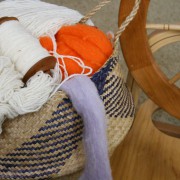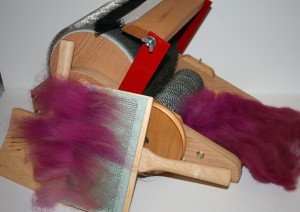Buying Things
In the Ply Ravelry group in the thread about what people would like to see in Ply, there has a been a bit of discussion going on about the stealth reviews. Some people are happy with them, and some people would like to see more about the downsides of the products being reviewed. It’s a fine line and I think Jacey did a good job of answering concerns and explaining that’s going on. You can check it out here: http://www.ravelry.com/discuss/ply-magazine/2611174/201-225#201
It got me to thinking more than usual about buying fiber tools and how to go about it. Since I owned a fiber shop I have thought about this question a lot but in the last year or so I’ve not been so invested in it for other people. But here I am, back again to thinking hard about the whole topic.
Here’s what I see happening. Somebody wants to buy a new thing. There are several makers of this thing and so it’s hard to decide which one to invest in. Fiber tools seem expensive and so this somebody doesn’t want to get it wrong. So they go to Ravelry/Facebook/Twitter/G+ and say, “I’m looking to buy a thing. Which thing do you recommend?” Then the spinner gets 1 million replies with all of the people saying that the thing that they own is the very best and all the other things are poorly made/don’t work/are stupid. Now the spinner is even more confused. What to do?!
Here’s my advice, since not everybody has a spinning shop within a couple of hours of their home where they can try things.
First, if you have a guild, take advantage of it. Ask people there if you can touch the tools they are using to see if they feel comfortable to you. If it’s a spinning wheel, it is not difficult to try the wheel with your own fiber and then take off the length that you spun even if they are in the middle of a bobbin. Most spinners are very happy to help.
If you don’t have a guild and you feel like you are out there on your own, chances are you aren’t – you just haven’t found the people yet, go with your gut. Don’t buy the cheapest thing but buy the best you can afford.
Here’s how this discussion goes in almost every class I teach.
Student: “Really? $75 for hand cards!?”
Me: “yep, that’s what they cost.”
Student: “Can’t I just use a dog brush?”
Me: “yes you can. But the tines aren’t as strong and you will be replacing them often and they cost $10 so once you replace them seven times over 7 years you will have paid the price for hand cards which will last more than 20 years at least. $70 over 20 years works out to $3.50 per year which is way cheaper than dog brushes over time.”
That’s how I feel about almost every spinning tool. Yes, the initial expense feels high but buying the right tool for the job will work better and the tool will last for almost your whole fiber life.
So, now, what if you buy a tool that’s not working for you? Well, there is a giant market for second hand tools. you won’t get what you paid for it but it will be close. Chalk this up to a learning experience. it’s like paying for a class. Now you know. Sell the thing and get a different one. There is somebody out there that will love it.
Also, when you are asking for opinions, be sure to talk to people who have tried more than one kind of thing. So many people will tell you that they just love their xbrand thingamajig and you should ahve one too when they’ve never even touched a different brand. And when people have a negative opinion about a thing, ask them why. It may be because the handle didn’t fit their small hand and you have a bigger hand so it won’t be an issue.
See? Easy.
Or you could just ask me. I have lots of opinions and they are all right.






I really enjoy the stealth reviews, when I read them I feel like they are well thought out and do point out what works and doesn’t work for them. Always best to try something in person if you can, fibre festivals or swap meets are another great opportunity to try new to you products.
I really like the stealth reviews. I think they give a lot of information,and they don’t always agree, which I think is natural and conducive to good choices being made. I would prefer to hear what is “right” about a product that what one person feels is “wrong” about it. That being said, the negative (from one person’s point of view) could be very helpful in the decision making process. Would it be possible to ask the question “What is one thing you would change about this product if you could?” It seems like that would be helpful to both your readers, and to the manufacturers. Just a thought. XX Thanks!
When I am tired or overwhelmed by information I have often wished to know some one who has lots of opinions that are always right.
I have learned, after many years, that beth is actually always right. It’s true.
But really, the stealth reviews are a tough one. Here’s what I wrote about them —
Stealth reviews are supposed to be honest, that’s why they’re all stealthy — so there’s no blowback on any of the spinners. I encourage people to be honest, not mean, but honest. The reviewers keep this in mind, as they probably should, that this is their opinion and that others may not feel the same way. I think they end up writing with care to that fact. I also think that spinners love the spinning community and as such, love the companies that make our tools, even if they don’t like the tool. I believe that reviewers, even knowing that they’ll get no blowback from a negative review, don’t want to be harsh because they don’t want their opinion to hurt a company that supports spinners and that some spinners must love. We’re nice like that. In the end, it makes for careful review writing.
I’m not sure there’s much way around this. I’ve been trying to pick reviewers that have something to say, something meaningful. Like for the current review I’m building, I want to hear what a lace spinner says about the item, what a new spinner says, and what a bulky/arty spinner says, I don’t think they’ll all say the same thing but I won’t know until I get the reviews.
As for why we pick the things we pick, it’s because we somehow think they fit in with the issue’s theme. Here’s why we don’t choose very small objects — (1) we only have the space to do 1 per issue and I like to showcase many of the small items in the SCENE or indie page. (2) I think those small items are less of a risk (at least monetarily) for spinners than the really big, expensive items. (3) I feel a small, relatively unknown object (like a woman turning a few spindles in her garage) could be more hurt by a damaging review than a larger company that already has fans and people that love it/talk about it/support it. Know what I mean? If the 3 people I happen to pick didn’t like her spindles, the dozens that potentially would have liked them will be turned off and she’ll find her business failing before it has a chance. I’d much rather feature those smaller items on the other pages.
As an aside, I don’t usually tell anyone what items are being featured in indie spinner, scene, or stealth reviews. It’s usually a surprise to the company.
It’s a hard issue, the reviews, one I struggle with.
Well said Jacey & Beth. You are always gonna get flack about how you choose to present things, but I think you are handling it in the most constructive and informative way. Thank you!
“I have lots of opinions and they are all right”….I just have to say I love you :)))
Recently purchased your book; great reading! BTW, I do realize that it is June, so this reply is rather late, but I’ve only just found this blog!